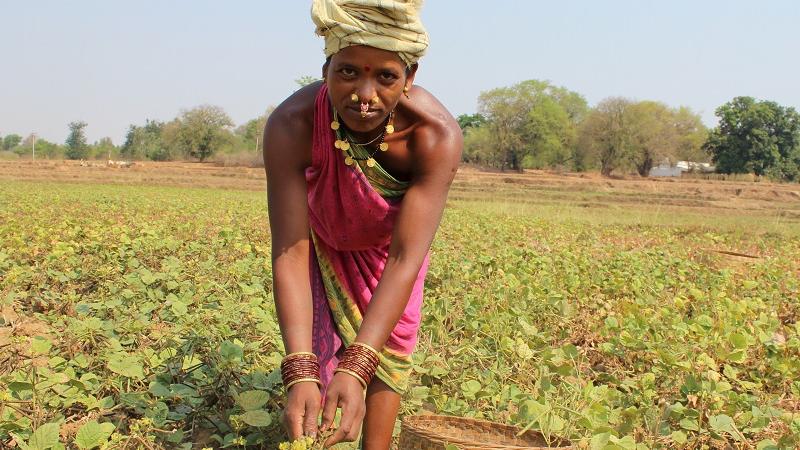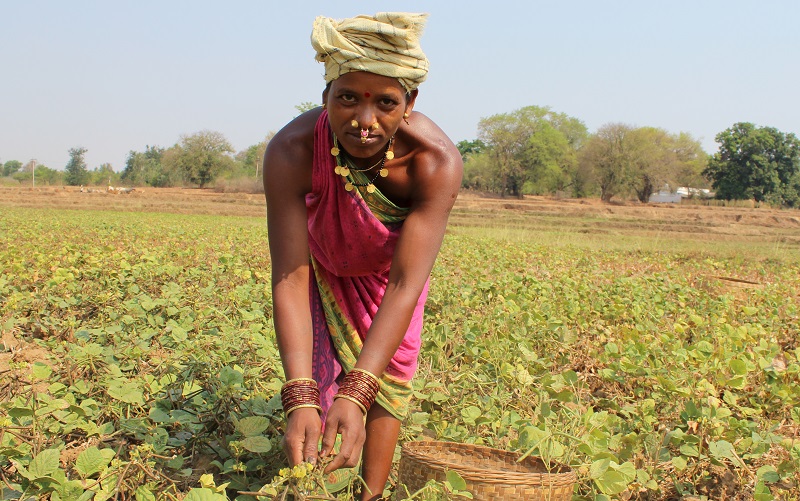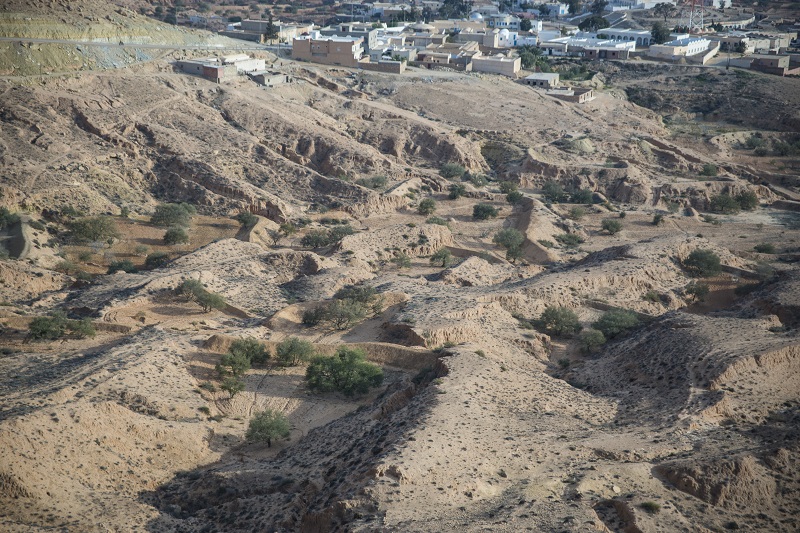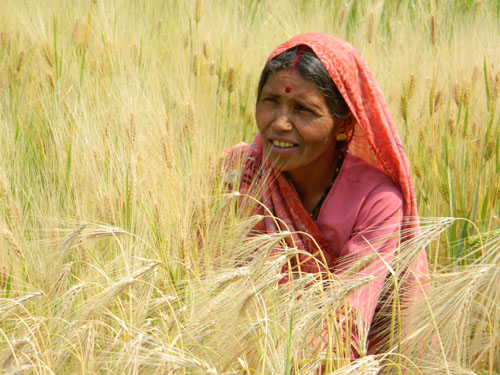Quarterly Newsletter - Issue 6, December 2016

‘Pulses Panchayat’: It takes a village to change a country

Urmila Pujari belongs to the Bhumia tribe of eastern state of Orissa in India, a culturally rich and one of the largest tribes in India. The tribe relies on farming for livelihood, but very few farmers cultivate pulses (food legumes). Urmila’s village of Bhejaguda is one the 28 tribal villages that has been brought into the folds of ‘Pulses Panchayat’, a bold and innovative movement that aims to revolutionize India’s pulses production.
India’s pulses sector is facing a crisis situation with supply shortage and an increasing dependence on imports. Imports reached 4.5 million tonnes in 2014-15, costing the nation US$2.8 billion. Inflated prices have made this traditional food and major source of nutrition unaffordable for millions of people.
Pulses production in India faces a number of constraints, including no major advances in production technologies, pests and disease, poor access to timely inputs, inefficient storage, and lack of market linkages and institutional support.
Pulses Panchayat could be the sweeping solution to all these challenges.
The approach, implemented by M. S. Swaminathan Research Foundation (MSSRF), an NGO in India, in partnership with local actors and backed by ICARDA, is aiming to bring clusters of entire villages under pulses production by mobilizing collective commitment and action from farming communities. Using the model of “panchayat” or village self-governance with the interest of farmers at the heart of it, the initiative is aligning all players in an “orchestrated symphony” to establish sustainable pulses production, value chains and marketing systems to foster pulses self-sufficiency for the entire nation.
The current average yield in India has stagnated at 0.75 tonnes per hectare (t/ha).
With improved technologies, Urmila was able to reap an impressive yield of 1.3 t/ha of green gram – enough to feed her family of three children, increase nutrition in their diets, and sell the surplus to market. Living on an annual household income of US$2800 per year, the gain had a substantial impact on her family income. Also sowing pulses after rice improved soil fertility, which reduced the use of chemical fertilizers like urea and ammonium nitrate that pollute the environment.
In all, the participating villages in Orissa generated close to US$150,000 worth of business with selling of pulses – an impressive show of the approach’s potential.
Earning the trust of tribes is not easy. The project in Orissa convinced 667 households to grow 400 acres of groundnut and 300 acres of black gram and green gram, paving the way for more villages to follow suit and grow pulses in coming seasons.
How’s it doing that? Read full story here.
The initiative aims to achieve national self-sufficiency by 2030, which means producing an additional 14 million tonnes. Bringing in fallow lands under cultivation is one part of the plan. But the low-hanging fruit is bridging the yield gap through improved technologies, which can double the yields up to 1.4 t/ha.
The project has been successfully piloted in states of Tamil Nadu and Orissa.
Not just within India, the Pulses Panchayat project is stimulating research and capacity building across in Morocco through the India Morocco Food Legumes Initiative (IMFLI), a south-south collaborative funded by Morocco’s OCP Foundation.
2016 International Year of Pulses comes to a close but Pulses Panchayat will continue to champion the cause to promote pulses and its many benefits for people and the planet.
Contributed by: Ravinder Reddy, Project Coordinator, M. S. Swaminathan Research Foundation (MSSRF)
Work funded by OCP Foundation (Morocco)
Gap in science and practice of land restoration

Land degradation is a defining issue of our times for a sustainable future. According to UNCCD, 52 percent of the land used for agriculture is moderately or severely affected by soil degradation. We lose as much as 12 million ha every year to degradation, a number expected to rise with climate change. Restoration of degraded lands is globally prioritized under the UN Sustainable Development Goals (SDG 15).
A number of restoration projects are under way around the world. However, to what extent these projects are guided by ecological restoration principles remains largely unknown.
A group of international researchers collaborating within the framework of European trans-national cooperation (COST Action ES1104) conducted a survey to investigate the extent of deviation and to shed light on gaps for better alignment between science and practice. The online survey directed toward restoration practitioners around the Mediterranean Basin, analyzed 36 restoration projects, mostly from the drylands.
The study found poor monitoring of the projects’ progress as one of the main shortcomings. In 22 percent of the projects surveyed, restoration success was never evaluated, while long-term (at least 6 years) evaluation was performed in mere 31 percent of the cases, using primarily plant diversity and cover as indicators.
The absent or deficient monitoring prevents the understanding of restoration trajectories, which precludes adaptive management strategies needed to enable effectively functioning ecosystems.
Undesired restoration results (e.g., inadequate biodiversity) were reported for 50 percent of the projects. The survey found use of sub-optimal materials in many cases, and non-native species in 47 percent of cases, driven by factors, such as faster growth rate, lower price, easy commercial availability, and/or aesthetics.
Previous efforts by restoration scientists to bring the science and the practice of restoration closer to each other were successful in changing the traditional narrow approach of afforestation to the more holistic model of ecological restoration that addresses both conservation and sustainable use of land for food production.
Another leap ahead is yet needed in restoration efforts. The survey revealed high variability among practices and highlighted the need for improved scientific assistance to enhance the real-word impact of the best-bet practices.
Interacting with the communities of practice is vital for scientists, and the Mediterranean survey offers a methodological example toward it.
Similar approaches if adopted by scientists to survey and develop networking with the communities of practice that their research targets, e.g., the communities of crop producers, institutions in charge of soil and water conservation, and agricultural service providers, can steer restoration efforts in the right direction and return more value in the long run.
Land restoration is not just a critical need but an opportunity. Restoring degraded lands will improve the productivity and increase the profitability for millions of smallholder farmers with poor crop yields. Further, an estimated 500 million ha of abandoned agricultural land can be brought back into food production, if done right.
The study titled “Ecological restoration across the Mediterranean Basin as viewed by practitioners” was published in Science of The Total Environment journal (October 2016). Read full paper.
Contributed by: Claudio Zucca, soil conservation/land management specialist, ICARDA
Work funded by CGIAR Research Programs on Dryland Systems and Water Land and Ecosystems
Dual purpose barley eases livelihoods in Himalayas

In the Himalayan mountains of India, feeding livestock during the cold months of winter is a major challenge for rural communities. Typically, village women collect green fodder from surrounding forests to feed their animals. But in peak winter months, there is not much greenery to be found.
Scientists have found a solution to promote green fodder production in the lean months of December and January through a 'dual-purpose' barley variety.
The innovation in barley allows two harvests for one crop sowing. Farmers can produce green fodder by cutting the crop within 70-75 days of sowing the seeds in the hills. After the cut, the crop is left to regenerate and harvested at full maturity in late May or June for grain and dry straw, used for both human consumption and animal feed. The cutting for fodder does not affect the final grain yield.
The barley variety, ‘BHS 380’, released from ICARDA germplasm with national partners in India, optimally combines traits of faster initial growth with higher biomass and better regeneration after cutting/grazing.
For best results, the appropriate stage for first cut must be optimized. If the cut is delayed, farmers may get even higher biomass as green fodder, but the regeneration may be poor and affect the grain yield.
The successful implementation of dual-purpose barley was made possible through ICARDA’s research partnership with CGIAR Research Program on Livestock and Fish and the Tata Trust-funded ‘Enhancing livelihoods through livestock knowledge systems’ project.
(See short video of the success story.)
Contributed by: Ramesh Verma, lead scientist for barley breeding program, ICARDA
Work funded by CGIAR Research Program on Livestock and Fish, Tata Trust Fund, Indian Council of Agricultural Research
In the SPOTLIGHT
Rebuilding agriculture in post-conflict countries
Andrew Noble, Deputy Director Research, ICARDA, explains in an interview with ABC Australia. Read more
Managing Editor: Rajita Majumdar
The International Center for Agricultural Research in the Dry Areas (ICARDA) works with countries in the world's dry and marginal areas to help increase productivity, raise smallholder incomes, improve nutrition and strengthen national food security.

Dryland Systems is global agricultural research partnership to realize the potential of dryland communities. The program is a CGIAR initiative led by ICARDA.
